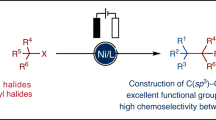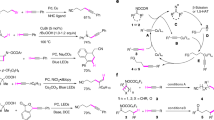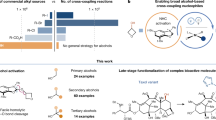Abstract
In the past 50 years, cross-coupling reactions mediated by transition metals have changed the way in which complex organic molecules are synthesized. The predictable and chemoselective nature of these transformations has led to their widespread adoption across many areas of chemical research1. However, the construction of a bond between two sp3-hybridized carbon atoms, a fundamental unit of organic chemistry, remains an important yet elusive objective for engineering cross-coupling reactions2. In comparison to related procedures with sp2-hybridized species, the development of methods for sp3–sp3 bond formation via transition metal catalysis has been hampered historically by deleterious side-reactions, such as β-hydride elimination with palladium catalysis or the reluctance of alkyl halides to undergo oxidative addition3,4. To address this issue, nickel-catalysed cross-coupling processes can be used to form sp3–sp3 bonds that utilize organometallic nucleophiles and alkyl electrophiles5,6,7. In particular, the coupling of alkyl halides with pre-generated organozinc8,9, Grignard10 and organoborane11 species has been used to furnish diverse molecular structures. However, the manipulations required to produce these activated structures is inefficient, leading to poor step- and atom-economies. Moreover, the operational difficulties associated with making and using these reactive coupling partners, and preserving them through a synthetic sequence, has hindered their widespread adoption. A generically useful sp3–sp3 coupling technology that uses bench-stable, native organic functional groups, without the need for pre-functionalization or substrate derivatization, would therefore be valuable. Here we demonstrate that the synergistic merger of photoredox and nickel catalysis enables the direct formation of sp3–sp3 bonds using only simple carboxylic acids and alkyl halides as the nucleophilic and electrophilic coupling partners, respectively. This metallaphotoredox protocol is suitable for many primary and secondary carboxylic acids. The merit of this coupling strategy is illustrated by the synthesis of the pharmaceutical tirofiban in four steps from commercially available starting materials.
This is a preview of subscription content, access via your institution
Access options
Subscribe to this journal
Receive 51 print issues and online access
$199.00 per year
only $3.90 per issue
Buy this article
- Purchase on Springer Link
- Instant access to full article PDF
Prices may be subject to local taxes which are calculated during checkout




Similar content being viewed by others
References
de Meijere, A. & Diederich, F. Metal-catalyzed Cross-coupling Reactions (Wiley-VCH, 2004)
Geist, E., Kirschning, A. & Schmidt, T. sp3-sp3 Coupling reactions in the synthesis of natural products and biologically active molecules. Natural Prod. Rep. 31, 441–448 (2014)
Haas, D., Hammann, J. M., Greiner, R. & Knochel, P. Recent developments in Negishi cross-coupling reactions. ACS Catal. 6, 1540–1552 (2016)
Phapale, V. B. & Cárdenas, D. J. Nickel-catalysed Negishi cross-coupling reactions: scope and mechanisms. Chem. Soc. Rev. 38, 1598–1607 (2009)
Jana, R., Pathak, T. P. & Sigman, M. S. Advances in transition metal (Pd,Ni,Fe)-catalyzed cross-coupling reactions using alkyl-organometallics as reaction partners. Chem. Rev. 111, 1417–1492 (2011)
Tasker, S. Z., Standley, E. A. & Jamison, T. F. Recent advances in homogeneous nickel catalysis. Nature 509, 299–309 (2014)
Qin, T. et al. A general alkyl-alkyl cross-coupling enabled by redox-active esters and alkylzinc reagents. Science 352, 801–805 (2016)
Giovannini, R., Stüdemann, T., Dussin, G. & Knochel, P. An efficient nickel-catalyzed cross-coupling between sp3 carbon centers. Angew. Chem. Int. Ed. 37, 2387–2390 (1998)
Zhou, J. & Fu, G. C. Cross-couplings of unactivated secondary alkyl halides: room-temperature nickel-catalyzed Negishi reactions of alkyl bromides and iodides. J. Am. Chem. Soc. 125, 14726–14727 (2003)
Terao, J., Watanabe, H., Ikumi, A., Kuniyasu, H. & Kambe, N. Nickel-catalyzed cross-coupling reaction of Grignard reagents with alkyl halides and tosylates: remarkable effect of 1,3-butadienes. J. Am. Chem. Soc. 124, 4222–4223 (2002)
Saito, B. & Fu, G. C. Alkyl–alkyl Suzuki cross-couplings of unactivated secondary alkyl halides at room temperature. J. Am. Chem. Soc. 129, 9602–9603 (2007)
Lovering, F., Bikker, J. & Humblet, C. Escape from flatland: increasing saturation as an approach to improving clinical success. J. Med. Chem. 52, 6752–6756 (2009)
Narayanam, J. M. R. & Stephenson, C. R. J. Visible light photoredox catalysis: applications in organic synthesis. Chem. Soc. Rev. 40, 102–113 (2011)
Prier, C. K., Rankic, D. A. & MacMillan, D. W. C. Visible light photoredox catalysis with transition metal complexes: applications in organic synthesis. Chem. Rev. 113, 5322–5363 (2013)
Jeffrey, J. L., Terrett, J. A. & MacMillan, D. W. C. O–H hydrogen bonding promotes H-atom transfer from α C–H bonds for C-alkylation of alcohols. Science 349, 1532–1536 (2015)
Terrett, J. A., Cuthbertson, J. D., Shurtleff, V. W. & MacMillan, D. W. C. Switching on elusive organometallic mechanisms with photoredox catalysis. Nature 524, 330–334 (2015)
Kalyani, D., McMurtrey, K. B., Neufeldt, S. R. & Sanford, M. S. Room-temperature C–H arylation: merger of Pd-catalyzed C–H functionalization and visible-light photocatalysis. J. Am. Chem. Soc. 133, 18566–18569 (2011)
Sahoo, B., Hopkinson, M. N. & Glorius, F. Combining gold and photoredox catalysis: visible light-mediated oxy- and aminoarylation of alkenes. J. Am. Chem. Soc. 135, 5505–5508 (2013)
Fabry, D. C., Zoller, J., Raja, S. & Rueping, M. Combining rhodium and photoredox catalysis for C-H functionalizations of arenes: oxidative Heck reactions with visible light. Angew. Chem. Int. Ed. 53, 10228–10231 (2014)
Zuo, Z. et al. Merging photoredox with nickel catalysis: coupling of α-carboxyl sp3-carbons with aryl halides. Science 345, 437–440 (2014)
Tellis, J. C., Primer, D. N. & Molander, G. A. Single-electron transmetalation in organoboron cross-coupling by photoredox/nickel dual catalysis. Science 345, 433–436 (2014)
Huihui, K. M. M. et al. Decarboxylative cross-electrophile coupling of N-hydroxyphthalimide esters with aryl iodides. J. Am. Chem. Soc. 138, 5016–5019 (2016)
Lowry, M. S. et al. Single-layer electroluminescent devices and photoinduced hydrogen production from an ionic iridium(III) complex. Chem. Mater. 17, 5712–5719 (2005)
Durandetti, M., Devaud, M. & Perichon, J. Investigation of the reductive coupling of aryl halides and/or ethyl chloroacetate electrocatalyzed by the precursor NiX2(bpy) with X− = Cl−, Br− or MeSO3− and bpy = 2,2′-dipyridyl. New J. Chem. 20, 659–667 (1996)
Gutierrez, O., Tellis, J. C., Primer, D. N., Molander, G. A. & Kozlowski, M. C. Nickel-catalyzed cross-coupling of photoredox-generated radicals: uncovering a general manifold for stereoconvergence in nickel-catalyzed cross-couplings. J. Am. Chem. Soc. 137, 4896–4899 (2015)
Lin, X. & Phillips, D. L. Density functional theory studies of Negishi alkyl–alkyl cross-coupling reactions catalyzed by a methylterpyridyl-Ni(I) complex. J. Org. Chem. 73, 3680–3688 (2008)
Ren, P., Vechorkin, O., von Allmen, K., Scopelliti, R. & Hu, X. A structure–activity study of Ni-catalyzed alkyl–alkyl Kumada coupling. Improved catalysts for coupling of secondary alkyl halides. J. Am. Chem. Soc. 133, 7084–7095 (2011)
Schley, N. D. & Fu, G. C. Nickel-catalyzed Negishi arylations of propargylic bromides: a mechanistic investigation. J. Am. Chem. Soc. 136, 16588–16593 (2014)
Meanwell, N. A. Synopsis of some recent tactical application of bioisosteres in drug design. J. Med. Chem. 54, 2529–2591 (2011)
Hartman, G. D. et al. Non-peptide fibrinogen receptor antagonists. 1. Discovery and design of exosite inhibitors. J. Med. Chem. 35, 4640–4642 (1992)
Acknowledgements
Financial support was provided by NIHGMS (R01 GM093213-01); we acknowledge gifts from Merck, AbbVie, and Bristol-Myers Squibb. C.P.J. thanks Marie Curie Actions for an international outgoing fellowship (PIOF-GA-2013-627695). S.A. thanks the Deutsche Forschungsgemeinschaft (DFG) for a postdoctoral fellowship (AL 1860/2-1).
Author information
Authors and Affiliations
Contributions
C.P.J., R.T.S. and S.A. performed and analysed experiments. C.P.J., R.T.S., S.A. and D.W.C.M. designed experiments to develop this reaction and probe its utility, and wrote the paper.
Corresponding author
Ethics declarations
Competing interests
The authors declare no competing financial interests.
Additional information
Reviewer Information
Nature thanks E. Peterson and the other anonymous reviewer(s) for their contribution to the peer review of this work.
Supplementary information
Supplementary Information
This file contains Supplementary Text and Data, Supplementary Figures 1-4, additional references and NMR Spectra. (PDF 8665 kb)
Rights and permissions
About this article
Cite this article
Johnston, C., Smith, R., Allmendinger, S. et al. Metallaphotoredox-catalysed sp3–sp3 cross-coupling of carboxylic acids with alkyl halides. Nature 536, 322–325 (2016). https://doi.org/10.1038/nature19056
Received:
Accepted:
Published:
Issue Date:
DOI: https://doi.org/10.1038/nature19056
This article is cited by
-
Nickel-electrocatalysed C(sp3)–C(sp3) cross-coupling of unactivated alkyl halides
Nature Catalysis (2024)
-
Congested C(sp3)-rich architectures enabled by iron-catalysed conjunctive alkylation
Nature Catalysis (2024)
-
Light-driven C–O coupling of carboxylic acids and alkyl halides over a Ni single-atom catalyst
Nature Synthesis (2023)
-
Visible light-driven conjunctive olefination
Nature Chemistry (2022)
-
Visible light-driven efficient palladium catalyst turnover in oxidative transformations within confined frameworks
Nature Communications (2022)
Comments
By submitting a comment you agree to abide by our Terms and Community Guidelines. If you find something abusive or that does not comply with our terms or guidelines please flag it as inappropriate.



